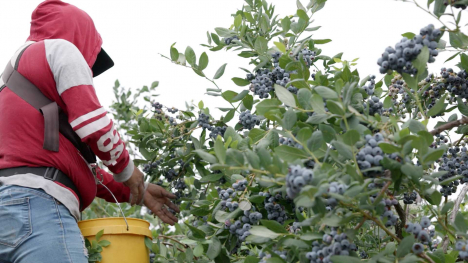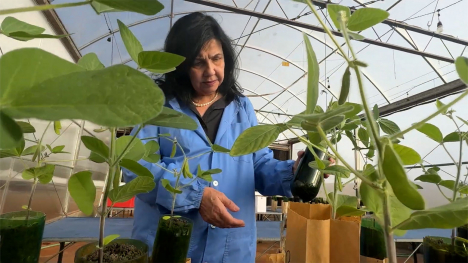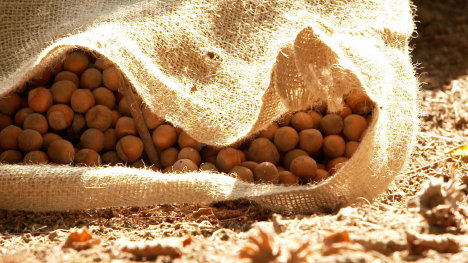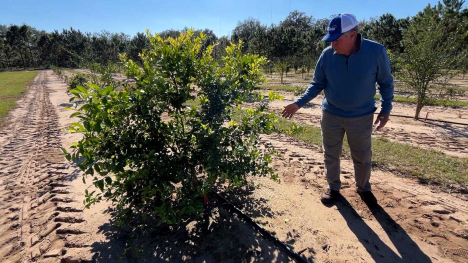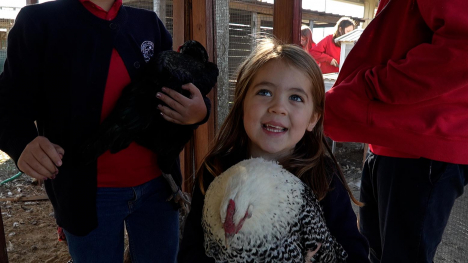
Science & Technology in Agriculture
Agriculture has a rich tradition of embracing technology to improve crop production, revolutionize how farmers run their business, and change the face of rural communities. Innovations such as the invention of the plow, refrigerated railcars, the Internet, and the development of genetically modified crops all have played pivotal roles in helping U.S. farmers become the most productive in the world.
Explore the stories about science and technology in agriculture. What do you think is the most important innovation? How will agricultural technology change in your lifetime?
Pagination
- Page 1
- Next page
Background
Agriculture has a rich tradition of embracing technology to improve crop production, increase efficiency, minimize environmental impacts, and more. Innovations ranging from the invention of the plow, refrigerated railcars, the Internet, and the development of genetically modified crops all have played pivotal roles in helping U.S. farmers become the most productive in the world, revolutionizing how farmers run their business, while also changing the face of rural communities.
Machines on the Farm
One of the first innovations to improve crop production happened when early growers realized yields improved if the soil was loosened prior to planting. As early as 4,000 B.C., farmers were using simple plows made of sticks pulled by humans or animals. As time progressed, and the global population expanded, farmers searched for more efficient ways to till the soil. The moldboard plow, for example, allowed the soil to be laid over old crops and weed seeds, leaving a clean furrow to plant new seeds. The addition of a steel plate by blacksmith John Deere in 1837 made it possible for iron plows to cut through the soil without having fresh earth stick to the moldboard. Today, global positioning systems can be found guiding tractors and combines using real-time data to plant seeds, apply chemicals and harvest crops.
Transportation
In the late 1800s, delivering peaches from a farmer in Oregon to a consumer in Missouri, or fresh cuts of beef from a meat-packing plant in Chicago to a consumer in Boston was a costly and time-intensive endeavor, and often resulted in spoilage before it reached its destination. The expansion of the railroad system in the late 1800s increased the speed and distance in which producers could deliver their product. The invention of the refrigerated rail car in 1878, revolutionized the meat industry by allowing producers to rapidly deliver perishable products. Today, ships, barges, trains, trucks, and other methods help transport products from farm to market. Advancements in transportation technology helped to open new markets, lower the cost of delivery, and ultimately improve the business of agriculture.
Increasing Yields
For many years, farmers have turned to agricultural chemicals, like pesticides and herbicides, to improve yields and reduce insect damage. Scientists have cross-pollinated plants of the same species (hybrids) to create certain traits, like drought tolerance. New biotechnology innovations are now used to create genetically modified organisms (GMOs) by inserting genes from one species of plant or bacteria into an entirely different species of plant. Like virtually every other technological advancement, GMOs and agricultural chemicals come with their own set of challenges and have initiated much debate about their use.
Crops as Energy
Farmers in the United States have regularly produced a reliable supply of food and fiber, but in recent years they have also produced an increasing share of the nation's fuel. In the wake of the Arab Oil Embargo of the 1970s, lawmakers implemented policies designed to provide more reliable supplies of energy. Corn-based ethanol and soybean-based biodiesel were developed to provide a homegrown, renewable alternative to petroleum-based energy. Critics contend alternative fuel production drives up food prices, while proponents say the products lower prices at the pump and help lessen the United State's addiction to foreign oil.
Feeding the World
The United Nations Food and Agriculture Organization (FAO) projects the world population will reach 9 billion by 2050. Since nearly 1 billion people around the globe are already counted among the ranks of the hungry, the FAO has called for a 100 percent increase in global food production by mid-century. Since the increased demand will be satisfied from virtually the same land area as today, the FAO concludes that 70 percent of the increased production must come from efficiency-enhancing technologies.
Some scientific and technical innovations have introduced challenges as well as rewards, with much debate about their costs and benefits to the environment, economy, and people. What is the most important scientific or technological innovation in agriculture? How will agricultural technology change in your lifetime?
Discovery Questions
- What do you think is the most important scientific, technical, or engineering innovation to impact the agriculture industry in the last 100 years? What evidence can you find to support your choice?
- Consider how science and technology in agriculture has evolved in the last 100 years. How do you envision it will change in your lifetime?
- What agriculture-related problems exist now that technology can help solve?
- Think about a new technology that you use, that you have seen in the news, or that was part of a science fiction movie. How might it be used in agriculture?
- How can you take an active role in advocating for science, technology and engineering in agriculture?
- How has technology changed the way farmers run their business and how commodities are traded?
- Consider where you will be and what you will be doing in twenty years. How will you be using science, technology, or engineering in your work?
- What types of ethical implications or unexpected consequences can arise with a scientific or technical innovation?
Challenge: Science & Technology in Agriculture
View and Print the Challenge | View and Print the Challenge Rubric
From the plow and selective breeding, to alternative fuels and robotics, American agriculture has seen numerous changes due to innovations in science, technology, and engineering. Some of these advancements have aided the American farmer in producing larger quantities of product on the same land area, or have allowed the production, transportation, trading, and retailing of agricultural products to be faster, better, or less expensive.
Your challenge is to imagine a new scientific, technical, or engineering innovation that will solve a problem. The problem can be one that exists now, or one that could happen in the future. Follow the process below as you consider the possibilities.
1. Define the Need
The first step is to identify a need that must be addressed. It could be a large, global problem such as world hunger, or it could be a situation that impacts you locally such as a polluted river or stream in your community. You could make a product taste better, or the workplace safer.
- Brainstorm a list of agricultural problems or opportunities that exist now or may exist in the future. The problems or needs can relate to any facet of the agriculture industry, such as production, processing, transportation, marketing, financing, or retailing.
- Based on your brainstorming, select one problem that you think science, technology, or engineering can play a part in solving.
- Describe the problem you are trying to solve or need that must be addressed. Why did you select it?
- Identify at least three stakeholder groups that are connected to the problem or need that must be addressed. For each, describe why they are a stakeholder and how they are currently impacted by the problem or need.
2. Find a Solution
Once you have identified the problem to be solved, find and describe a scientific, technical, or engineering innovation that meets the need.
- Make a list of at least three possible scientific or technical achievements that could be applied to solve your problem. What is the best choice? Identify your choice and explain why it was selected.
- Design a solution to the problem. There are many ways to do this such as drawing a sketch, writing a description, creating an outline, or creating a computer-based design. You may have to use your creativity to imagine a scientific or technological advancement that may not yet exist. Use appropriate method(s) to communicate your solution.
3. Consider the Impact
Any new innovation can have positive and negative impacts. A new technology could revolutionize the marketplace or help feed millions of people, or it could have environmental consequences or be too expensive for the marketplace. Explore the impacts of your innovation.
- Identify at least two potential problems or challenges to implementing your design. Does the technology or science currently exist? Is it expensive? How might government policy/legislation impact the implementation of your design? How might you address these challenges?
- Identify at least two risks with your innovation. Would there be any safety, environmental, economic, or ethical implications you would need to confront? If there are no risks, explain why.
- What would be the impact of your idea? How will it benefit the stakeholders you identified? How will it solve the problem or need you identified? How would you measure this impact?
4. Make it Happen
Having an innovative idea is one thing, making it come to reality is another. Make a plan for creating and marketing your idea.
- What steps could you take to make your idea a reality?
- What are the types of costs involved to create your innovation?
- What types of individuals or business would you need to make and market your idea? Create a list of 3-5 individuals or businesses you would need to work with in order to create and market your solution.
Related Resources
- STEM Career Lab Collection
Explore careers in STEM including agricultural engineering. PBSLearningMedia - Quest: The Science of Sustainability Collection
This collection of media resources present information on some of today’s most pressing sustainability topics, including water, food and energy. PBSLearningMedia, Quest
Teacher Notes
Module Overview
The Science & Technology in Agriculture module demonstrates agriculture's long history of technological innovations and their impact on the world. It expands on specific innovations to discuss their impact on the economy, environment, science, government, transportation, culture and society. The module challenges the reader to consider what the future of agriculture will be and what ethical considerations might be involved.
This module introduces students to several big ideas. Science and technology have played a role in agriculture since the first crops were planted. This continues today with genetic engineering, robotics, GPS, and other developments quickly changing the face of agriculture.
Learning Goals
This module connects with the following learning goals:
- Identify existing problems that can be solved through innovations in technology.
- Demonstrate the key components of the design process including identifying a problem, brainstorming possible solutions, designing, testing, and evaluating.
- Explain the impacts of outside entities, such as government or business, in the development of a new agricultural science or technology.
- Analyze ethical implications or considerations for a new agricultural science or technology.
- Hypothesize future applications for a new agricultural science or technology.
View and Print the Challenge | View and Print the Challenge Rubric
